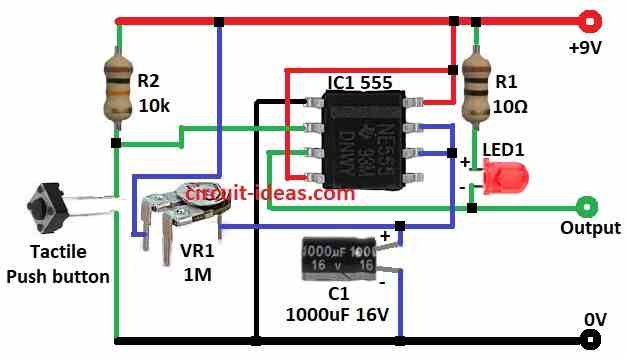Simple 60 Second Timer Circuit using IC 555 is used to control time in many electric works.
This Simple 60 Second Timer Circuit uses 555 timer IC and a famous chip for timing jobs.
Press push button and LED turns ON for about 1 minute.
This circuit is good for delay lights, fun projects or learning electronics.
Circuit Working:

Parts List:
| Component | Specification | Quantity |
|---|---|---|
| Resistors | 10Ω 1/4 watt | 1 |
| 10k 1/4 watt | 1 | |
| Preset 1M | 1 | |
| Capacitors | Electrolytic 1000μF | 1 |
| Timer IC 555 | 1 | |
| Tactile Push-Button Switch | 1 | |
| LED any 5mm 20mA | 1 | |
| Power Supply 9V Battery | 1 |
Simple 60 Second Timer uses push button, capacitor, resistors, VR1, LED and 555 timer in monostable mode.
In monostable mode:
Pin 3 output goes LOW until pin 2 get pulse.
After trigger pin 3 is HIGH for set time and then gets back LOW.
Steps:
Start with pin 3 LOW.
Press button and pin 2 get LOW pulse and timer starts.
Pin 3 goes HIGH and LED gets ON.
Time is set by VR1 and R2 and C1.
After time pin 3 goes LOW and LED goes OFF.
Adjust VR1 to change time.
For 1 minute delay VR1 = 55kΩ.
Formulas and Calculations:
Timer Time (T):
T = 1.1 × R_total × C
where:
- R_total is R2 + VR1
- C is 1000μF
For 60 sec timer:
R_total = 55kΩ
T = 1.1 × 55000 × 0.001
T = 60.05 sec = 1 min
So set VR1 to 55kΩ to get 1 minute timer.
How to Build:
To build a Simple 60 Second Timer Circuit using IC 555 is mentioned below for connections:
- Take all parts as shown in diagram.
- Pin 1 of 555 IC connects to GND.
- Pin 2 connects to push button and other side of button to GND.
- R2 connects between pin 2 and +9V.
- Pin 3 connects to LED1 and R1 and then to +9V which is the output.
- Pins 4 and pin 8 connects to +9V.
- Pins 6 and pin 7 connect to one side of VR1 and other side of VR1 to +9V.
- C1 positive connects to pins 6 and pin 7 and C1 negative connects to GND.
Conclusion:
This Simple 60 Second Timer Circuit using IC 555 shows how to make time delay.
Change VR1 or C1 to set different time.
It is good for beginners to learn basic circuit and timer use.
It is an easy design and works well which is useful for small projects.
Leave a Reply